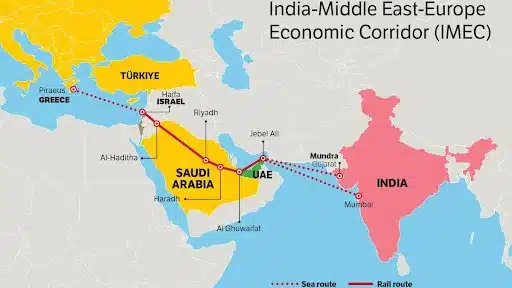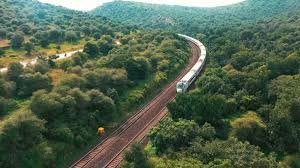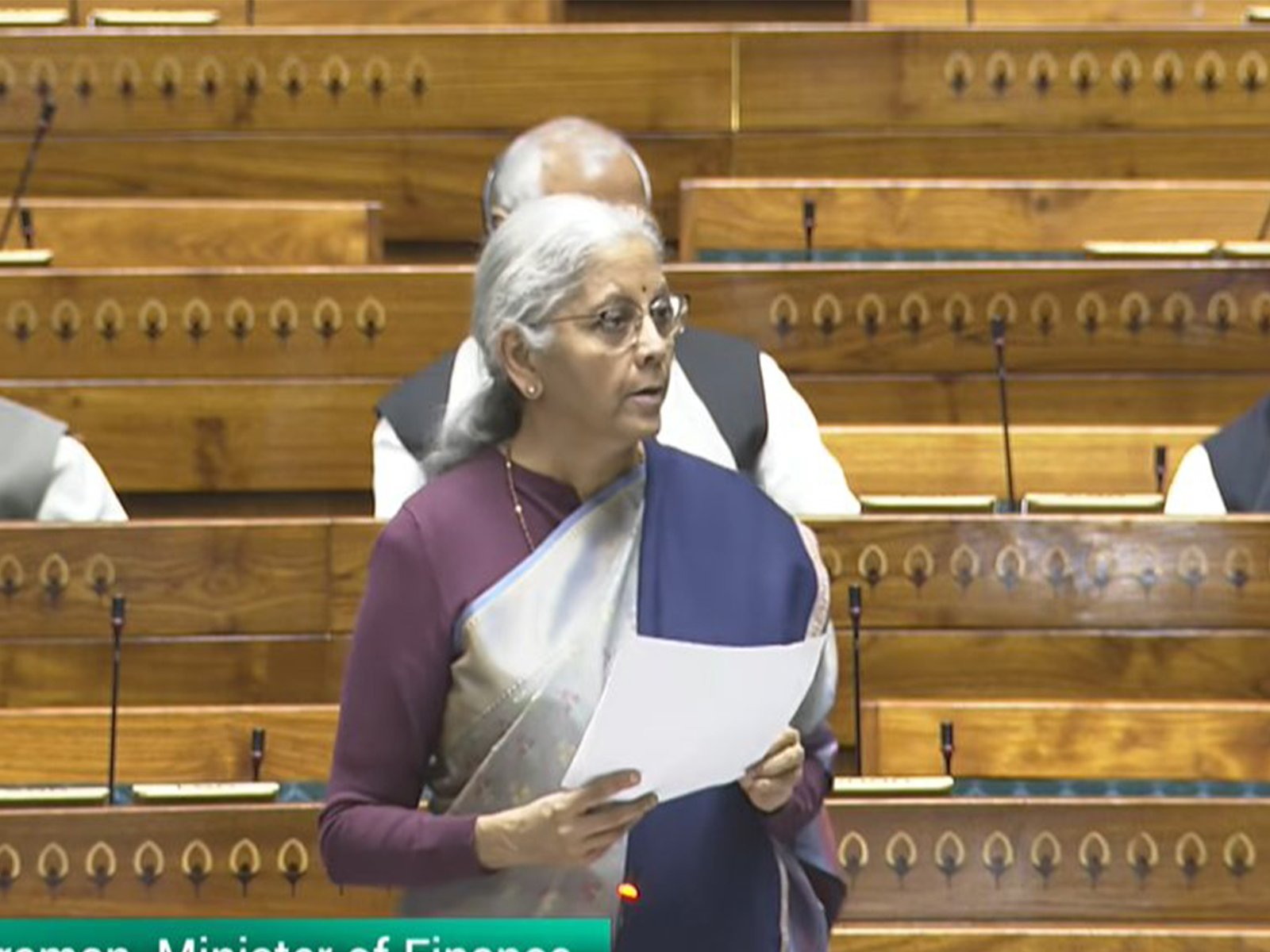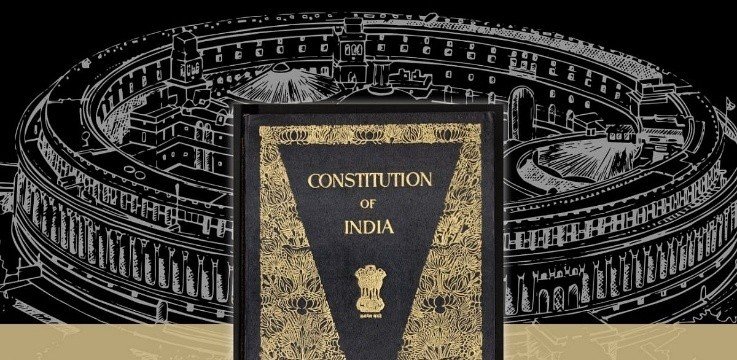Why in the News?
- India is promoting the India–Middle East–Europe Economic Corridor (IMEC) to connect India with the Gulf region and Europe through railways, ports, pipelines and digital cables.
- The plan was launched during the G20 Summit in Delhi (2023), but recent conflicts in West Asia and global trade route changes have made its future uncertain.
Key Highlights
- What is IMEC?
- IMEC aims to connect Indian ports with Gulf ports through sea routes and then extend by rail through Saudi Arabia and Jordan to Haifa (Israel). From Haifa, goods would move to Europe by sea.
- The plan also includes:
- A clean hydrogen pipeline for green energy,
- An electricity cable, and
- An undersea digital data cable.
- Background and favourable conditions
- In 2023, conditions looked good for IMEC because of the Abraham Accords, which improved relations between Israel and Arab nations.
- India had strong ties with UAE, Saudi Arabia, and Israel, and the I2U2 group (India, Israel, UAE, USA) showed how these countries could cooperate.
- European nations and the EU supported the project, seeing it as a way to strengthen trade with India.
- Setbacks after 2023
- The Hamas–Israel conflict (October 2023) created new security tensions in West Asia, affecting trust and regional cooperation.
- Rising attacks on ships in the Red Sea (by Houthis) also made existing trade routes more risky and expensive.
- New trade route competition
- Climate change has opened up the Arctic sea route, which shortens travel time between Asia and northern Europe. This could reduce the importance of Mediterranean ports.
- Countries like Italy and France, which rely on the Mediterranean, see IMEC as a way to stay relevant in global trade.
- Why IMEC still matters
- IMEC can help diversify global trade and reduce dependence on a single trade route or country (especially China).
- It connects India’s fast-growing economy with Europe’s technology and high-income markets.
- The EU is India’s largest trading partner (trade worth about $136 billion).
- IMEC can also promote clean energy, digital cooperation, and supply-chain resilience.
Key Terms
- Economic Corridor
- A planned network connecting countries through transport, energy and digital routes to promote trade, investment and regional cooperation.
- Multimodal Connectivity
- Using different transport modes (like sea, rail, road, and pipeline) in a coordinated way to move goods faster and at lower cost.
- Blended Finance
- Combining public funds and private investment to support big infrastructure projects and reduce financial risks.
- Supply Chain Resilience
- The ability of trade and production systems to keep working during crises like wars, pandemics or natural disasters by using alternative routes or suppliers.
- Green Hydrogen Pipeline
- A system that carries hydrogen made from renewable energy (like solar or wind) to industries and other countries, helping reduce carbon emissions.
Implications for India
- Diversified trade routes: IMEC will give India alternative and safer routes to reach European markets.
- Economic growth: Faster and more reliable transport can reduce costs and help Indian exporters.
- Energy security: The proposed hydrogen pipeline and electricity links can boost India’s renewable energy cooperation.
- Stronger global role: India’s leadership in IMEC can increase its influence in West Asia and Europe.
- Strategic balance: It helps India build a counter to China’s Belt and Road Initiative (BRI) by offering an alternative corridor.
Challenges and Way Forward
| Challenges | Way Forward |
| Regional instability due to wars and political tensions in West Asia | Adopt a phased approach, start with stable regions first. |
| Huge financial needs and coordination among many countries | Use blended finance (public + private funding) and work with international agencies. |
| Competition from Arctic routes | Focus on faster, more reliable services via Mediterranean ports. |
| Different rules and standards across countries | Create common trade and transport regulations and digital customs systems. |
| Environmental and local concerns about big infrastructure | Ensure green, sustainable construction and local participation. |
Conclusion
The IMEC project is a big step to connect India with West Asia and Europe through modern, green and secure infrastructure. It can strengthen India’s trade, energy, and global partnerships. However, success depends on maintaining peace in West Asia, ensuring financial cooperation, and building trust among all participating nations.
| EnsureIAS Mains Question Q. Explain the strategic and economic significance of the India–Middle East–Europe Economic Corridor (IMEC). What are the main challenges India faces in making this corridor a reality? (250 Words) |
| EnsureIAS Prelims Question Q. With reference to the India–Middle East–Europe Economic Corridor (IMEC), consider the following statements: 1. IMEC plans a high-speed rail network connecting Gulf ports with Haifa in Israel. 2. The Abraham Accords helped create a favourable political environment for IMEC. 3. IMEC includes plans for hydrogen and digital cables along with rail and sea routes. 4. The Arctic sea route increases IMEC’s strategic importance for all European nations equally. Which of the statements given above are correct? Answer: A. 1, 2 and 3 only Explanation: Statement 1 is Correct: IMEC includes a rail link from Gulf ports to Haifa (Israel) for transport to Europe. Statement 2 is Correct: The Abraham Accords improved Israel–Arab ties, helping IMEC gain support. Statement 3 is Correct: IMEC also includes green hydrogen, electricity and digital cables, not just transport routes. Statement 4 is Incorrect: The Arctic route benefits mainly northern Europe, not all European countries equally. Southern countries like Italy and France still depend on Mediterranean trade. |
Also Read | |
| UPSC Foundation Course | UPSC Daily Current Affairs |
| UPSC Monthly Magazine | CSAT Foundation Course |
| Free MCQs for UPSC Prelims | UPSC Test Series |
| ENSURE IAS NOTES | Our Booklist |





